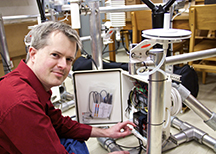EAPS team part of national tornado study 'VORTEX Southeast'
02-29-2016
 |
|
Daniel Dawson, assistant professor of earth, atmospheric and planetary sciences at Purdue University, works on a disdrometer that will be used to measure the size and velocity of raindrops and hailstones during severe weather. Dawson is part of a Purdue-led team that is part of the national VORTEX-SE tornado field study. (Purdue University photo/Tim Brouk) |
WEST LAFAYETTE, Ind. — A team of Purdue University researchers will be in the field studying severe weather this spring to better understand the processes that lead to tornado development and society's vulnerability to these severe weather hazards.
Michael Baldwin, associate professor in Purdue's Department of Earth, Atmospheric and Planetary Sciences, leads the team that was selected as one of nine to be a part of the Verification of the Origins of Rotation in Tornadoes Experiment Southeast, or VORTEX-SE.
The National Oceanic and Atmospheric Administration National Severe Storms Laboratory is executing VORTEX-SE, which will run March 1 through April 30 in the southeastern United States.
Congress initiated the VORTEX-SE project, which is supported by a special Congressional allocation of more than $5 million to the National Oceanic and Atmospheric Administration or NOAA, because of the devastating impact tornadoes have had in this region, Baldwin said.
"As compared to the Great Plains, the southeastern United States experiences more unexpected tornadoes from small storms, tornadoes at night and tornadoes outside of the traditional 'tornado season, ' " said Baldwin, who also is affiliated with the Purdue Climate Change Research Center in Purdue's Discovery Park. "Because of these and other factors this area of the U.S. has had a disproportionate loss of lives from tornadoes. Highly populated areas are threatened and perhaps less prepared with adequate storm shelter, which makes them very vulnerable. The VORTEX Southeast project answers the urgent need to understand the unique storms in this region as well as cool-season storms and tornadoes in general."
VORTEX-SE is a research program to understand how environmental factors characteristic of the southeastern United States affect the formation, intensity, structure and path of tornadoes in this region. VORTEX-SE also will determine the best methods for communicating forecast uncertainty related to these events to the public and evaluate public response, said Erik Rasmussen, project manager of VORTEX-SE for NOAA.
"This is the first VORTEX experiment to focus on tornado hazards as a whole, from the storms and conditions that produce tornadoes, to forecasting, detection and warning, to the way communities and individuals receive and respond to those warnings," Erik Rasmussen, project manager of VORTEX-SE for NOAA and research meteorologist with the university of Oklahoma Cooperative Institute for Mesoscale Meteorological Studies said. "It is important to bring the communication and social sciences into the mix with the meteorology and atmospheric sciences. All are critical components to saving lives."
In addition to Baldwin, the Purdue team includes assistant professors in Purdue's Department of Earth, Atmospheric and Planetary Sciences Robin Tanamachi, Daniel Dawson and Daniel Chavas; professor in Purdue's Department of Earth, Atmospheric and Planetary Sciences Ernest Agee; and Stephen Frasier of the Microwave Remote Sensing Laboratory at the University of Massachusetts.
The Purdue-led team will deploy mobile radars, weather balloons and instrument packages to observe the storms and take relevant measurements including pressure, humidity, temperature, wind speed and direction, rain drop and hail stone sizes and rain or snowfall.
The team also will create a high-resolution simulation of tornadic convection and a sophisticated weather prediction and tornado risk assessment model. More information about the Purdue-led project is available at the VORTEX-SE website.
Purdue also was a part of the last VORTEX project, VORTEX 2, which was the largest tornado and storm field study in history. Tanamachi and Dawson performed fieldwork and participated in data analysis for the project.
The VORTEX-SE field study will involve 40 physical and social science researchers from 20 research entities, many located in the southeast. They will deploy approximately 13 vehicles, three mobile radars and one fixed radar from their operations base at the University of Alabama-Huntsville.
VORTEX-SE activities are being supported by a special Congressional allocation of more than $5 million to NOAA made in 2015. A similar allocation made this year will support additional activities in the spring of 2017, according to NOAA.
Writer: Elizabeth K. Gardner, 765-494-2081, ekgardner@purdue.edu
Sources: Michael Baldwin, 765-494-0345, baldwin@purdue.edu
Robin Tanamachi, rtanamachi@purdue.edu
Daniel Dawson, dandawson@purdue.edu
Daniel Chavas, dchavas@purdue.edu
Ernest Agee, 765-494-3282, eagee@purdue.edu
Related website:
NSSL VORTEX-SE: https://www.nssl.noaa.gov/projects/vortexse/impacts/
Related news releases:
Purdue swept up in largest tornado field study in history https://www.purdue.edu/uns/x/2009a/090521TrappVORTEX2.html
NOAA, University of Alabama-Huntsville and Partners Kick Off Tornado Study
https://blog.nssl.noaa.gov/nsslnews/2016/02/noaa-university-of-alabama-huntsville-and-partners-kick-off-tornado-study/
Related video: https://www.youtube.com/watch?v=4xqewtcWTV8&feature=youtu.be
Note to Journalists: Robin Tanamachi is participating in the VORTEX-SE media day on Monday (Feb. 29) in Huntsville, Alabama. To arrange an on-site interview, contact Keli Pirtle, NOAA communications, at 405-203-4839. The media day advisory is available at https://www.noaa.gov/noaa-university-alabama-huntsville-and-partners-kick-tornado-study. Other members of the Purdue team are available for interview on Purdue’s campus. Please contact Elizabeth Gardner, Purdue News Service, at 765-494-2081, ekgardner@purdue.edu